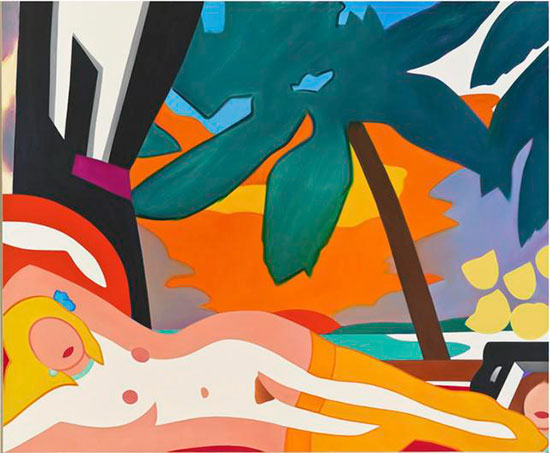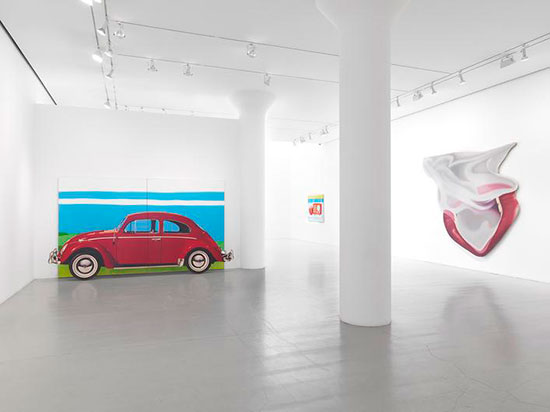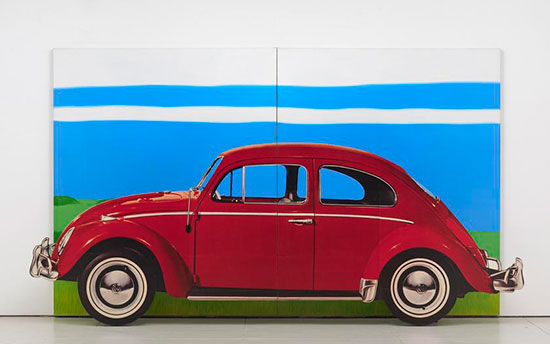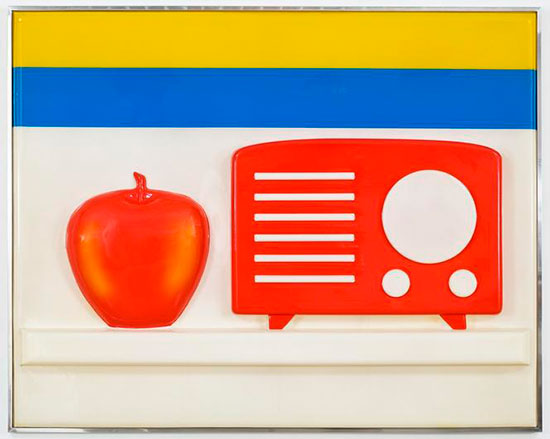The color red has had its champions throughout art history, including such titans as Titian, Rubens, Modigliani and Matisse. Tom Wesselmann’s name also belongs on this honor roll, as the many red highlights of a current show at Mitchell-Innes & Nash in Chelsea attest.
This exhibition is the first substantive painting retrospective of the Pop master’s work in New York since his death in 2004. Organized in partnership with the artist’s estate, it selectively deploys a mere dozen important works that cover a surprisingly broad range of media and span the best-known decades of Wesselmann’s career, from 1961 to the 1980s.
Red in many gradations of hue, value and chroma dominates the most lushly painted work in the show, Great American Nude #19 (1961), an oil on Masonite stunner. It poses a smoldering redhead blushing from head to toe on a scarlet divan before a table in burgundy. This piece is an early entrant in Wesselmann’s most famous series dedicated to the “Great American Nude.” The artist would continue to add to this running collection of smoking (often literally) sirens throughout his career.
.

"Great American Nude #19" by Tom Wesselmann, 1961. Oil and mixed media collage on masonite, 36 x 48 inches. Courtesy Mitchell-Innes & Nash.
.
Great American Nude #19 packs as much heat as the ruby reds in the Modigliani reclining nude that heated up the front pages of newspapers after its sale broke a world record at Christie’s last season. As with the high-temperature Modigliani, Wesselman’s nude has the sinuous contours of the body surrounded with a pulsing aura of color.
On the next wall to the left of this earliest work in the show, the same strategy is at work in Sunset Nude with Big Palm Tree (2004) a much larger (and stiffer) oil on canvas painting from the same series that was made in the last year of Wesselmann’s life. Here, too, the woman’s body is engulfed in bands of color, rather like the echoing contours that Matisse and Kandinsky used for their odalisques, leaning on highly saturated colors to expand the presence of the figure.
.

"Sunset Nude with Big Palm Tree" by Tom Wesselmann, 2004. Oil on canvas, 105 x 128 inches. Courtesy Mitchell-Innes & Nash.
.
Wesselmann once acknowledged the influence of Matisse in no uncertain terms: “I can’t talk about Matisse without talking about myself,” Wesselmann said. “He is the painter I most idolized and I still do.” Bright red lip shapes slyly populate the sunset in the background, reminders of Wesselmann’s longstanding oral fixation, which is the basis for a huge shaped canvas of an open mouth, Smoker #14 (1974), billowing pale cigarette smoke from lips glazed with bright lipstick. This painting exudes enough sensuality to dominate an entire wall of the gallery.
.

"Tom Wesselmann" at Mitchell-Innes & Nash. Right: "Smoker #14," 1974. Courtesy Mitchell-Innes & Nash.
.
Like James Rosenquist, who knew a thing or two about making mouths open, Wesselmann is a Pop master who hewed closely to the billboard aesthetic. Both artists negotiated the trading zone between raunchy eroticism and object-oriented banality.
One of the last shows at the old Whitney space (now Met Breuer) paired Wesselmann’s nudes with those by Richard Lindner under the rubric “Sinister Pop,” a fair enough label, but I always felt there was a cleanliness to Wesselmann’s aesthetic that differentiated him from the noirish Lindner and even Warhol. That scrubbed, shiny brightness is the dominant impression of the show at Mitchell Innes & Nash, where the work gleams against expanses of white wall flooded with cold light.
Born in Cincinnati in 1931, Tom Wesselmann studied psychology at the University of Cincinnati before leaving in 1953 for a two-year stint in the army, where he took up cartooning. After the army he decided to pursue drawing cartoons so he enrolled at the Art Academy of Cincinnati and then he changed to fine art, his major at Cooper Union in New York, where he earned his degree in fine art in 1959.
During the Sixties, the artist’s Great American Nude series and the shaped canvases became his carrying card, while in the 1970s the still life attracted his attention, as it had for Roy Lichtenstein. In 1980, at the beginning of the decade when he introduced his metal cut-outs, Wesselmann released a humorous autobiography under the pen name Slim Stealingworth.
His career seemed to move inexorably toward creating an extra dimension, as his paintings took on the sculptural quality of shaped canvases and pushed into the gallery space, becoming more and more three-dimensional. The stunning economy of Wesselmann’s compositions was from the start a matter of paring down the image to a silhouette, especially in steel-cut reliefs that imposed squiggling black lines on the wall.
The apotheosis of the combined billboard graphic punch, clean contour and manipulation of three-dimensional space is the show-stopping Landscape #5 (1965). This piece superimposes a trompe l’oeil ruby red Volkswagen in oil on shaped canvas, at one-to-one scale, set against two panels of green, blue and white background landscape.
.

"Landscape #5" by Tom Wesselmann, 1965. Liquitex and collage on canvas and oil on shaped canvas, 84 x 144 1/2 x 18 inches. Courtesy Mitchell-Innes & Nash.
.
The waxed and polished bug is lovingly rendered, down to the gleaming chrome highlights on its hubcaps and bumpers. The patently fake liquitex on canvas background (in two panels) of a green meadow, blue sky and bands of white cloud seems to scroll by behind the car like a patently fake movie background. It is charming the way the bumpers jut out past the edges of the background set.
The jarring contrast between styles is as provocative as the unlikely intrusion of the car parked in the pure space of the gallery. Family resemblances emerge between the Beetle’s red body and the shapely women cavorting around it. The installation of the show noses the car into a corner of the gallery catty-corner to Seascape #10 (1966) a witty sendup of the marine genre that lifts a slender white leg—the Great American Nude kicking up some sand—against a fake ocean horizon.
.

"Seascape #10" by Tom Wesselmann, 1966. Molded Plexiglas painted with gripflex, 44 1/2 x 58 1/2 x 1 3/4 inches. Courtesy Mitchell-Innes & Nash.
.
Wesselmann fashioned it into an elliptical medallion of molded plexiglass painted with Gripflex stretching nearly five feet across the wall. Bug or leg, heads or tails, Wesselmann’s icons spin the coin and shamelessly play to the probabilities of familiar desires with a deadpan evenness of tone.
The focused exhibition is notable for its breadth of techniques. Wesselmann, like Lichtenstein, was an irrepressible experimenter with materials; he helped pioneer the steel-cut method. At Mitchell-Innes & Nash, many of the artist’s ventures into different media are on view, from collage to assemblage and shaped canvases. A steely still life incorporates a working clock and electric fan.
I will doubtless never again in my checkered career as a critic have the opportunity to note that the medium of a basic and cheerful still life (Still Life #53, dating from 1964) is “painted molded plastic (Gripflex on uvex).”
.

"Still Life #53" by Tom Wesselmann, 1964. Painted molded plastic (Gripflex on uvex), 47 1/2 x 58 x 5 inches. Courtesy Mitchell-Innes & Nash.
.
For those who have not resurfaced an airport runway or bridge entrance ramp in some time, Gripflex is a sealant that can take a beating from the traffic of Navy fighter jets for up to 15 years, while uvex is the scuff resistant plastic known to skiers and wearers of safety goggles.
Elevated to the status of oil on canvas and taking their place in the still life ranks, these materials, like the red radio that dominates the composition, leap from low to high in that deft transition that Pop artists appear to pull off so effortlessly.
_______________________________
BASIC FACTS: “Tom Wesselmann” is on view April 21 to May 28, 2016 at Mitchell-Innes & Nash, 534 West 26th Street, New York 10001. www.miandn.com.
_______________________________
Copyright 2016 Hamptons Art Hub LLC. All rights reserved.
